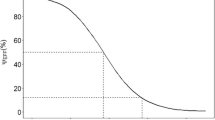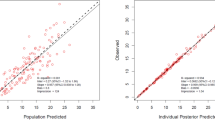Abstract
Background Recommendations on drug dose adjustment in patients with renal impairment may vary between the references. It is often unknown which approach the dosing schemes were based on and what drug exposure is likely to be achieved. Objective To develop a simple method to evaluate recommended dosing schemes for patients with renal impairment, to apply this method to selected antibacterial drugs in order to evaluate expected drug concentrations using dosing schemes recommended for patients with severe infections, and to evaluate the expected consequences. Setting This was a theoretical study, which was based on data from published clinical trials. Methods Clinically established dosing schemes for 46 antibacterial drugs, as recommended for patients with renal impairment in the Summary of Product Characteristics, were analysed using a newly developed graphical method. Consistency of the dosing schemes with two general dose adjustment rules, the proportional rule and the eliminated fraction rule, was determined and drug exposure was predicted. Main outcome measure Predicted drug exposure. Consistency of recommended dosing schemes with the general dose adjustment rules. Results Only 30 % of the recommended dosing schemes were associated with similar average concentrations as expected in patients with normal renal function (44 % were associated with higher and 26 % with lower concentrations). The highest median exposure was found in beta-lactams (170 %, range 58–443 %, for creatinine clearance of <15 ml/min, and 155 %, range 54–232 %, for creatinine clearance of 15 to <30 ml/min), where the medians were significantly different from 100 % (P < 0.02). Consistency with a dosing rule was found in 59 % of the dosing schemes (proportional rule 46 %, eliminated fraction rule 50 %, both rules 4 %). Conclusions Relative low exposure was found for several drugs, including ceftazidime, cefotaxime, imipenem, erythromycin, ciprofloxacin, levofloxacin, and teicoplanin, where dosing schemes should be reconsidered or used only in clinical situations where a lower than maximum exposure appears adequate. General application of the proportional rule for calculating drug dose adjustments would lead to lower than clinically established dose practice for 44 % of drugs.


Similar content being viewed by others
References
Matzke GR, Aronoff GR, Atkinson AJ Jr, Bennett WM, Decker BS, Eckardt KU, et al. Drug dosing consideration in patients with acute and chronic kidney disease-a clinical update from Kidney Disease: improving Global Outcomes (KDIGO). Kidney Int. 2011;80:1122–37.
Dettli L. Drug dosage in renal disease. Clin Pharmacokinet. 1976;1:126–34.
Dettli L. The kidney in pre-clinical and clinical pharmacokinetics. Jpn J Clin Pharmacol. 1984;15:241–54.
Hartmann B, Czock D, Keller F. Drug therapy in patients with chronic renal failure. Dtsch Arztebl Int. 2010;107:647–55.
Kunin CM. A guide to use of antibiotics in patients with renal disease. A table of recommended doses and factors governing serum levels. Ann Intern Med 1967;67:151–8.
Vidal L, Shavit M, Fraser A, Paul M, Leibovici L. Systematic comparison of four sources of drug information regarding adjustment of dose for renal function. BMJ. 2005;331:263.
World Health Organization. The selection and use of essential medicines. World Health Organ Tech Rep Ser 2011; 965:i–xiv,1–249.
Czock D, Keller F, Paar WD, Thalhammer F. Renal replacement therapy in critically ill patients: how to dose antibiotics during continuous hemofiltration. Intensiv- und Notfallbehandlung. 2008;33:169–83.
Czock D, Keller F. Dosing adjustment according to Dettli’s rule: measured pharmacokinetics in kidney patients versus urinary recovery in healthy individuals [abstract]. Br J Clin Pharmacol. 2009;68(Suppl 1):22.
Obach RS, Lombardo F, Waters NJ. Trend analysis of a database of intravenous pharmacokinetic parameters in humans for 670 drug compounds. Drug Metab Dispos. 2008;36:1385–405.
van Dalen R, Vree TB, Baars AM, Termond E. Dosage adjustment for ceftazidime in patients with impaired renal function. Eur J Clin Pharmacol. 1986;30:597–605.
Aronoff GR, Bennett WM, Berns JS, Brier ME, Kasbekar N, Mueller BA, et al. Drug prescribing in renal failure. Philadelphia: American College of Physicians; 2007.
Verpooten GA, Verbist L, Buntinx AP, Entwistle LA, Jones KH, De Broe ME. The pharmacokinetics of imipenem (thienamycin-formamidine) and the renal dehydropeptidase inhibitor cilastatin sodium in normal subjects and patients with renal failure. Br J Clin Pharmacol. 1984;18:183–93.
Campise M. Neurological complication during imipenem/cilastatin therapy in uraemic patients. Nephrol Dial Transplant. 1998;13:1895–6.
Sacristán JA, Soto JA, de Cos MA. Erythromycin-induced hypoacusis: 11 new cases and literature review. Ann Pharmacother. 1993;27:950–5.
MacGowan AP, White LO, Brown NM, Lovering AM, McMullin CM, Reeves DS. Serum ciprofloxacin concentrations in patients with severe sepsis being treated with ciprofloxacin 200 mg i.v. bd irrespective of renal function. J Antimicrob Chemother. 1994;33:1051–4.
Jones EM, McMullin CM, Hedges AJ, Lovering AM, White LO, Reeves DS, et al. The pharmacokinetics of intravenous ciprofloxacin 400 mg 12 hourly in patients with severe sepsis: the effect of renal function and intra-abdominal disease. J Antimicrob Chemother. 1997;40:121–4.
Pea F, Poz D, Viale P, Pavan F, Furlanut M. Which reliable pharmacodynamic breakpoint should be advised for ciprofloxacin monotherapy in the hospital setting? A TDM-based retrospective perspective. J Antimicrob Chemother. 2006;58:380–6.
Derbyshire N, Webb DB, Roberts D, Glew D, Williams JD. Pharmacokinetics of teicoplanin in subjects with varying degrees of renal function. J Antimicrob Chemother. 1989;23:869–76.
Martin-Facklam M, Rengelshausen J, Tayrouz Y, Ketabi-Kiyanvash N, Lindenmaier H, Schneider V, et al. Dose individualisation in patients with renal insufficiency: does drug labelling support optimal management? Eur J Clin Pharmacol. 2005;60:807–11.
Crandon JL, Ariano RE, Zelenitsky SA, Nicasio AM, Kuti JL, Nicolau DP. Optimization of meropenem dosage in the critically ill population based on renal function. Intensive Care Med. 2011;37:632–8.
Patel N, Scheetz MH, Drusano GL, Lodise TP. Identification of optimal renal dosage adjustments for traditional and extended-infusion piperacillin-tazobactam dosing regimens in hospitalized patients. Antimicrob Agents Chemother. 2010;54:460–5.
Eyler RF, Mueller BA. Antibiotic pharmacokinetic and pharmacodynamic considerations in patients with kidney disease. Adv Chronic Kidney Dis. 2010;17:392–403.
Czock D, Markert C, Hartman B, Keller F. Pharmacokinetics and pharmacodynamics of antimicrobial drugs. Expert Opin Drug Metab Toxicol. 2009;5:475–87.
Keller F, Borner K, Schwarz A, Offermann G, Lode H. Therapeutic aminoglycoside monitoring in renal failure patients. Ther Drug Monit. 1987;9:148–53.
Eyler RF, Mueller BA. Antibiotic dosing in critically ill patients with acute kidney injury. Nat Rev Nephrol. 2011;7:226–35.
Pea F, Viale P, Furlanut M. Antimicrobial therapy in critically ill patients: a review of pathophysiological conditions responsible for altered disposition and pharmacokinetic variability. Clin Pharmacokinet. 2005;44:1009–34.
Funding
The authors received no funding for the present study.
Conflicts of interest
The authors declare no conflict of interest.
Author information
Authors and Affiliations
Corresponding author
Electronic supplementary material
Below is the link to the electronic supplementary material.
Rights and permissions
About this article
Cite this article
Czock, D., Spitaletta, M. & Keller, F. Suboptimal antimicrobial drug exposure in patients with renal impairment. Int J Clin Pharm 37, 906–916 (2015). https://doi.org/10.1007/s11096-015-0141-0
Received:
Accepted:
Published:
Issue Date:
DOI: https://doi.org/10.1007/s11096-015-0141-0




